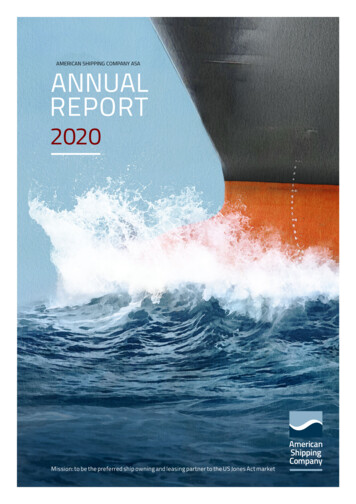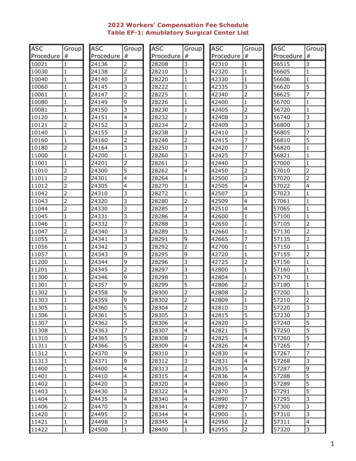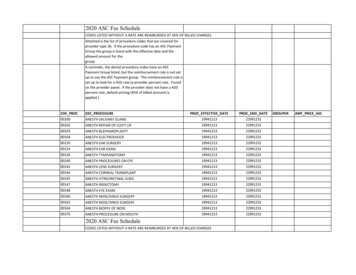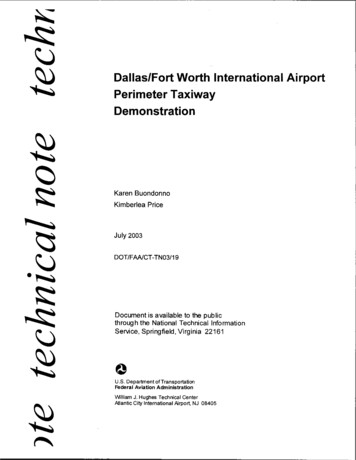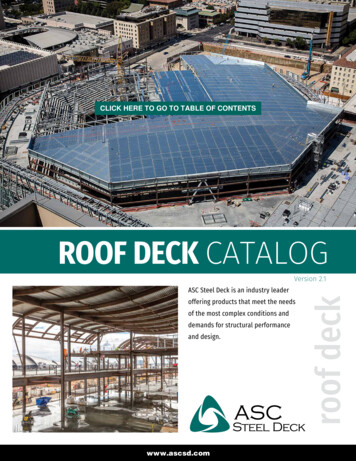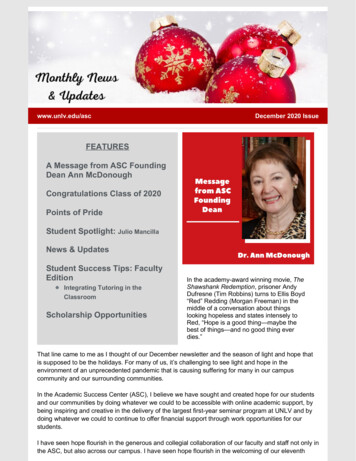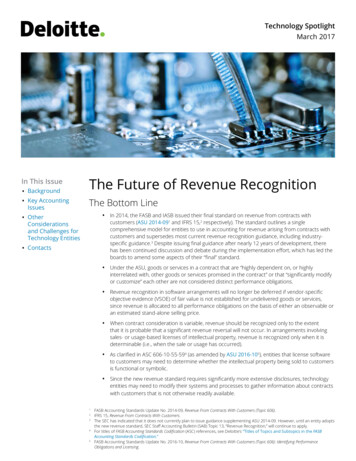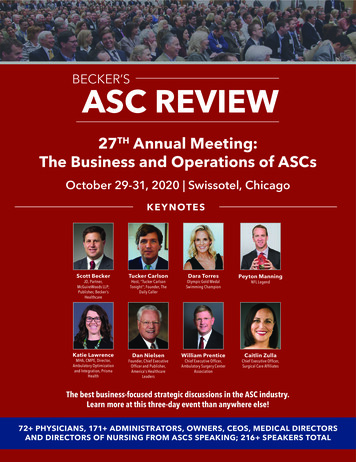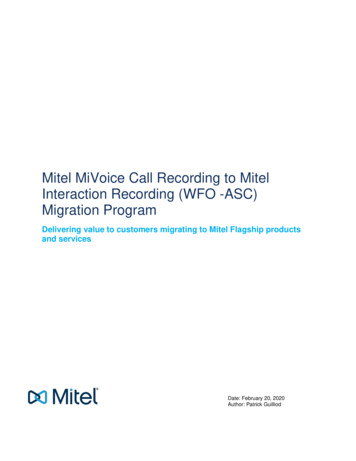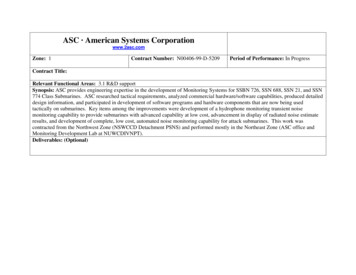
Transcription
ASC · American Systems Corporationwww.2asc.comZone: 1Contract Number: N00406-99-D-5209Period of Performance: In ProgressContract Title:Relevant Functional Areas: 3.1 R&D supportSynopsis: ASC provides engineering expertise in the development of Monitoring Systems for SSBN 726, SSN 688, SSN 21, and SSN774 Class Submarines. ASC researched tactical requirements, analyzed commercial hardware/software capabilities, produced detaileddesign information, and participated in development of software programs and hardware components that are now being usedtactically on submarines. Key items among the improvements were development of a hydrophone monitoring transient noisemonitoring capability to provide submarines with advanced capability at low cost, advancement in display of radiated noise estimateresults, and development of complete, low cost, automated noise monitoring capability for attack submarines. This work wascontracted from the Northwest Zone (NSWCCD Detachment PSNS) and performed mostly in the Northeast Zone (ASC office andMonitoring Development Lab at NUWCDIVNPT).Deliverables: (Optional)
Zone: 2, 3Contract Number: T0701BG0473Period of Performance: 11/2/2001Contract Title:Relevant Functional Areas: 3.1 R&D SupportSynopsis: ASC has also provided Research and Development Support to NAVSEA 06/NSWC HQ SURFTECH. In support ofsurface ship advanced technology development and transformation, the surface ship community is working to implement a sustainabletechnology management process. The process, more commonly known as SURFTECH, was chartered to assist the Science andTechnology (S&T) and Research and Development (R&D) communities to coordinate and build a consolidated technology vision forthe future Surface Navy. SURFTECH is composed of a Flag Chaired IPT (OPNAV 76, SEA 06 and COMNAVSURFLANT), 6working groups comprised of personnel from OPNAV, CNSL, CNSP, NAVSEA/PEO’s, NSWC and assorted other field activities anda dedicated office within SEA 06/NSWC HQ. ASC has been part of the SURFTECH office and process since near its inception andhas been providing technical support the entire time. Functional task areas include 1) participating in the development andstandardization of a repeatable and quantifiable SURFTECH Process for the evaluation and scoring of technology insertion candidatesinto the Surface Navy; 2) Facilitate interaction/coordination with external organizations (DASN SHIPS, DASN RDT&E, ONR,OPNAV, PEOs, PMs, Field Activities, Laboratories, etc.); 3) participating in the evaluations of and provide recommendations on therelative surface technology initiatives and programs; 4) participating in SURFTECH Investment strategy development and theestablishment of S&T and R&D programmatic priorities.Deliverables: (Optional)
Zone: 2, 4Contract Number: M6784-98-F-0023Period of Performance: May 2003Contract Title:Relevant Functional Areas: 3.1 R&D SupportSynopsis: ASC has over 25 years of experience developing innovative systems engineering solutions for submarine systemsintegration, technology insertion, mission planning, and organizational design. Our experience spans multiple programs and allacquisition phases, including concept formulation, preliminary and detailed design, prototype development and test system production,deployment and integration, test and evaluation, and in-service support.NSWC Crane/Joint Non-Lethal Weapons Directorate Anti-Terrorism/Force Protection (AT/FP): In conjunction with the Navy’sAT/FP coordination and execution efforts, ASC, under task from the Joint Non-Lethal Weapons Directorate and NSWC Crane isproviding engineering subject matter expertise for the development and implementation of AT/FP systems which will enable Navysurface ships to detect, deter and mitigate insurgent threats. The AT/FP program is a compilation of Program Offices, FieldActivities, Laboratories, Operational Commands, etc that are joining together to work to mitigate the ongoing asymmetric threat to ournaval forces ashore and afloat, especially with respect to the threat posed by terrorist insurgents. ASC is working directly withNSWC Crane, Louisville, Panama City in support of their technical efforts to field AT/FP systems. ASC is providing technicalanalysis and acting as a conduit for technical information between the primary program participants.Deliverables: (Optional)
Zone: 1Contract Number: N66004-02-D-0940Period of Performance: In ProgressContract Title:Relevant Functional Areas: 3.2 Engineering SupportSynopsis: ASC provides System Engineering Support Services for Non-Propulsion Electronics System (NPES) onboard USSVIRGINIA Class submarines. This includes planning problem resolution, and data analysis for System Management, Navigation,Radar, and other systems. ASC provided technical support for adapting Government developed software to the submarineenvironment. ASC participated in design and development meetings and integration testing at the Lockheed Martin EngineeringDevelopment Model.Deliverables: (Optional)
Zone: 1Contract Number: GS07T00BGD0030Period of Performance: In ProgressContract Title:Relevant Functional Areas: 3.2 Engineering SupportSynopsis: ASC has provided submarine and anti-submarine warfare (ASW) concept engineering to the Navy Warfare DevelopmentCommand (NWDC) in support for Fleet Battle Experiments. This included providing definition and interpretation of high-levelorganizational performance requirements, abstracts and concept studies, and analysis studies. ASC also provided IT systems analysisand assessment reports that support innovation in USW, multi-national operational concepts, and IT architectures for network-centricwarfare. ASC participated in the NWDC interdisciplinary Warfare Innovation Development Team (WIDT).Deliverables: (Optional)
Zone: 2Contract Number: N00024-01-D-2903Period of Performance: 9/30/02Contract Title:Relevant Functional Areas: 3.2 Engineering SupportSynopsis: ASC has over 25 years experience in submarine design and construction, and in the development, installation, integration,testing and certification of systems aboard all classes of US Navy Submarines. Our Non-Propulsion Electronics System (NPES) andCommand & Control System (CCS) technical support to the NAVSEA Participating Managers and Ship Acquisition Managersrequired detailed in-depth knowledge of the electronic and Hull Mechanical & Electrical (HME) functions of all NPES and CCSsubsystems in order to achieve successful integration with the platform and compliance with the operational requirements. Our uniqueexperience, corporate knowledge, and knowledge of the ship design process and specifications, HM&E specifications, NPES and CCSsubsystems and shipboard environmental requirements, has enabled us to smoothly integrate systems with a variety of hullconfigurations, sail designs, equipment arrangements and data distribution systems. We have assisted our customer in certifying NPESand CCS GFI submitted to the Planning Yards for the TRIDENT program and Los Angeles Class program, and maintain voluminoustechnical files documenting electrical and mechanical interfaces to the SSN and SSBN platforms. Our experience in the dualevolutions of Submarine NPES and CCS have enabled us to ensure our customers reliable, well-integrated ship/systems.Deliverables: (Optional)
Zone: 2Contract Number: GS10K00BKM0029Period of Performance: OngoingContract Title:Relevant Functional Areas: 3.2 Engineering SupportSynopsis: ASC has over 25 years of experience in EMC and topside design engineering support. We have provided this support aboard U.S. Navy Cruisers, Destroyers, Frigates, Carriers, USCGCutters and Royal Norwegian Navy Icebreakers.ASC has provided NAVSEA with engineering expertise with the following examples of support: Assessment to determine inter & intra-ship EME levels at proposed composite deck house location in DDG 51 class ships for NSWCDD J54 Conducted EM analyses to determine optimum LHA 4, 5 and LHD 3, 5 Integrated Topside Designs for PMS470 Conducted EM analyses for NFN and CDL-N installations on board AGF 3 and LCC 19 Conducted EM analyses to determine optimum AGF 11 Integrated Topside Design for PMS470 Provided technical engineering support to the LPD 17 EMCAB for the past 7 years Provided technical engineering support to the AOE 6/10 Class EMCAB and conducted various EM analyses for sensor installations Provided Topside Engineering support to Surface Combatants Topside Integration Group (SC-TIG) Engineered Ship Wide Area Network (SWAN) in LPD 17 Design and Installation Liaison support for Commercial & Military SATCOM Systems Identify potential EMI problems to/from systems installed in CG 47 Class Cruiser Conversion, other ships in the Battle Group and shore based systems due to the High Power Discriminator-XBand (HPD-X) Provided Engineering support during weekly LHA(R) Integrated Process Review (IPR) meetingsUsing existing documentation (reports, databases, matrices) we have investigated known EMI problems between transmit/receive systems within the Fleet. Using shipboard system characteristics we canpredict electromagnetic field levels expected for new system installations, and/or to support development of system susceptibility requirements. Electric field levels & power densities from systems arecalculated aboard various ship platforms within a BG to ensure that system level requirements comply with shipboard standards and specifications. ASC applied RCS coverage requirements for locatingtopside antennas, identify potential in-band and out-of-band EMI problems and known resolutions to predicted EMI problems.ASC has implemented integrated topside design processes (3 Phase) established by PMS 470 to recommend an optimum topside configuration. Analyses involve topside design for concurrentantenna installations aboard specified ship classes.Assess reaction time of sensors and weapons utilizing NAVSEA’s EM Engineering Software. Software can accomplish assessment in relation to azimuth and elevation coverage, type ofthreat, and system parameters that can impose restrictions on the systems performance. These factors can originate from intra-ship and inter-ship platforms, terrain, weather, or unfriendly/hostile forces.Depending on the combination, types, and severity of these factors, the reaction time of sensors and weapons may be degraded sufficiently to result in decreased warfighting capability.Research potential intra/inter-ship in-band and out-of-band signals, and determine installation, maintenance and cabling requirements. Provide blockage estimations. Determine operationalconstraints of the system, EMC limits, RADHAZ, and potential radiation pattern distortion. Estimate structural modifications required for installation, if any, including cost and solution flexibility.Provide potential problem resolutions as they apply.Deliverables: (Optional)
Zone: 3Contract Number: N65236-99-A-7927Period of Performance: 9/30/03Contract Title:Relevant Functional Areas: 3.2 Engineering SupportSynopsis: Provided engineering support to Wireless LAN programs including: SubLAN Technical Management and Oversight (includes integration oversight). Wireless SubLAN Baseline design and development of system and hardware/software requirements, including ComponentSelection. Prepared Wireless Network Design Guides for each Sub class. -Conducted feasibility analysis to determine the feasibility of interfacing the AN/WSN-7 Ring Laser Gyro Navigation Systemover long distances to various combat system components in geographically dispersed integration test sites. Designed, developed and procured a Voice Over IP (VoIP) system on USS JFK. Completed preliminary analysis of PCS RF radiators Prepared a usage study of PCS Wireless systems currently installed. Developed the AGF-3 PCS wireless upgrade design.As part of a large trainer upgrade the ASC Team will deliver Device 2F166-2, currently a Group "0" E-2C OFT, to CAEWWL at NASNorfolk, VA, after being refurbished, redesigned and upgraded to a Group II/Navigation Upgrade E-2C configuration. ASC will alsodeliver a new visual system for Device 2F166-2 .ASC will modify Device 2F166-2 from the current four-blade propeller configurationto the new NP2000 eight-blade propeller system including upgrading the cockpit configuration, providing new aerodynamic model,and upgrading all affected aircraft systems based upon data collected at flight testing. Upgrades of additional E-2C Flight trainers areincluded in this contract.Deliverables: (Optional)
Zone: 3, 4Contract Number: N61339-00-D-0021-07Period of Performance: OngoingContract Title:Relevant Functional Areas: 3.2 Engineering SupportSynopsis: ASC will deliver Device 2F166-2, currently a Group "0" E-2C OFT, to CAEWWL at NAS Norfolk, VA, after beingrefurbished, redesigned and upgraded to a Group II/Navigation Upgrade E-2C configuration. ASC will also deliver a new visualsystem for Device 2F166-2 .ASC will perform complete engineering technical support to upgrade the cockpit configuration, providenew aerodynamic model, and upgrade all affected aircraft systems based upon data collected at flight testing.Deliverables: (Optional)
Zone: 6Contract Number: N68936-01-F-0209Period of Performance: 4/11/2002Contract Title:Relevant Functional Areas: 3.2 Engineering SupportSynopsis: ASC, under contract to NAVAIR, provided system engineering/technical support to the PHD NSWC Detachment WhiteSands as part of the detachment’s modernization efforts. The ASC team consisted of system engineers, qualified technicians andprogram management experts. The engineering task provided systems engineering efforts to the NSWC PHD Det White Sandstowards the evaluation of the current architecture and determination of modernization requirements, specifically for DESERT SHIPbut encompassing the entire Navy infrastructure at White Sands. It provided the systems engineering and technical details towardsmodernizing technical capabilities and greater usage of available Detachment capabilities that would be needed to support theimplementation of the NSWC PHD Det White Sands Business Development. ASC provided a consolidated course of action forimproving the overall capabilities of DESERT SHIP including an architectural definition process, obsolete equipment replacementrequirements, DESERT SHIP LAN development and remote launcher communications capabilities. The business and systemsengineering efforts were integrated together and coordinated as parallel efforts in order to move towards the detachment’s end goal –improving the business posture of NSWC PHD Det White Sands and improving its support of overall Department of Defense programobjectives. ASC is currently a subcontractor on the PHD NSWC Det White Sands OMNIBUS contract awarded to New Mexico StateUniversity Physical Sciences Laboratory.Deliverables: (Optional)
Zone: 1Contract Number: N6604-03-D-0017Period of Performance: In ProgressContract Title:Relevant Functional Areas: 3.3 ModelingSynopsis: ASC has developed models of transducers to measure effectiveness of sensors during at-sea conditions as part of oursupport to NUWC Code 2131. Development of models has been used to estimate the effectiveness and durability of differentTransducer designs.Deliverables: (Optional)
Zone: 2Contract Number: GS-07T00BGD0030 Period of Performance: OngoingContract Title:Relevant Functional Areas: 3.3 ModelingSynopsis: ASC has performed Topside Analyses utilizing 3D CAD models and EM Engineering Software Tools. Individual 3D engineeringcomputer models are developed and implemented in documenting Topside Design and Electromagnetic Compatibility analysis for each shipplatform. NAVSEA’s electromagnetic (EM) engineering toolset is utilized to import 3D ship models into several engineering programs todetermine blockage, antenna performance due to the effects of ship structure and antenna-to-antenna coupling.The ship model is imported into EMDAT, where antennas and other topside equipment are added to the ship structure. A different baseline modelis constructed to reflect each topside arrangement option. For assessing optical blockage, separate EMDAT 3D models are imported into theBlockage Analysis Model (BAM). For assessing gain reduction from ship’s structure and coupling from other topside electronic systems, theGeneral Multiple Scattering Code (GMULT) and the General Coupling Code (GCUPL) are used, respectively. If it is determined that reflectionsor diffractions may cause system degradation, the Ray Tracing and Casting (RTC) program is used to determine what, if any structure may causereflections or diffractions and provide a solution to these potential problems. EMGEO (Electromagnetic Geometry Modeler)This database enables the topside design engineer to apply EM analysis tools onto 3-dimensional ship models and provides a gateway for easyaccess to various topside arrangements.BAM (Blockage Analysis Model)Displays optical blockages of topside solid structures, provides an estimation of weapons cam cutout zones from calculated coverages andblockages, and allows for the display of near field power densities from high powered radars applied to the ship's 3D geometry.RTC (Ray Tracing & Casting)Assists the EM design engineers to visualize and quantify microwave propagation, quantifies the EME at specific topside locations and identifiespotential EMI and RADHAZ areas.GMULT (General Multiple Obstacles and Scattering Model)Permits the topside design engineer to predict antenna performance resulting from blockage effects of multiple, arbitrarily-oriented topsidecomponents which is useful early in ship design process.Deliverables: (Optional)
Zone: 4Contract Number: N61339-00-D-0021-06Period of Performance: 06/30/03Contract Title:Relevant Functional Areas: 3.3 ModelingSynopsis: ASC completed work on the design, development and production of a new Air Intercept Radar Trainer (AIRT)/GroundMapping Radar Trainer (GMRT) APG-66 Training System that supports the training conducted in the T-39 aircraft at TRAWING Six,NAS Pensacola, Florida with extensive modeling. The trainers are designed to provide part task radar training for undergraduate,cross-service, Military Flight Officers. A total of ten networked Training Systems were produced and delivered under this program.Deliverables: (Optional)
Zone: 1, 3Contract Number: GS-23-F-0129Jorder 79180Period of Performance: OngoingContract Title:Relevant Functional Areas: 3.3 ModelingSynopsis: ASC is continuing to support the US Army (TACOM-ARDEC) at Picatinny Arsenal, NJ, in all aspects associated with theConcept Exploration Program (CEP). The CEP is intended to develop, model, evaluate, and identify alternative system concepts thatalone or in the aggregate satisfy the various assigned mission tasks from within the operational context as defined by the Joint users.There are five distinct phases used in this process that have value and that will also contribute to the planning, development, andexecution of the USACE Strategic Plan.The phases are: 1) Definition Phase (the operational concept, preliminary desired operational characteristics, and draft performanceparameters are identified and technology options are developed); 2) Assessment Phase (initial concepts are assessed by evaluatingdelivery methods, deployments methods, payloads, target effects and responses, maturity, complexity, and overall risk against therequirements, where expert opinion, technical analyses, and modeling and simulation are used to make the assessments); 3) AnalysisPhase (selected concepts are subjected to in-depth assessment of the Analysis of Alternatives; concepts are matured throughengineering and modeling and simulation); 4) Comparison Phase (concept data is evaluated using expert personnel and professionalsoftware to support decision requirements; Measures of Effectiveness and Measures of Performance are developed; developmentalrisk is ascertained; performance parameters are described; and all aspects of integrated logistics, human effects, and life cycle cost aredeveloped for an acquisition authority); and 4) Review and Approval Phase (finalize the recommendations and supporting data inpreparation for recommending an acquisition solution through the Milestone Decision Authority (MDA) and eventually through aJoint Flag/General Officer decision body).These efforts are conducted because decision-makers need reliable, objective assessments of the options for meeting real missionneeds, assess force structure implications, identify potentially viable solutions and provide comparative cost-effectiveness assessmentsof each solution to a baseline, typically representing current capabilities.Deliverables: (Optional)
Zone: 4Contract Number: N61339-00-D-002101Period of Performance: 10/30/04Contract Title:Relevant Functional Areas: 3.4 PrototypingSynopsis: ASC developed prototype F-14 Visual Systems Upgrade Program involving the visual systems upgrades for Device 2F169Weapon System Trainer (WST T-2), Device 2F153 Mission Flight Trainer (MFT), and Devices 2F154 Weapon System Trainers(WST 1 and 2) located at Fighter Training Squadron VF101 at NAS Oceana, VA. The upgraded visual systems provide the F-14aircrews with an inproved out-the-window visual environment for training.Deliverables: (Optional)
Zone: 1Contract Number: N6604-03-D-0017Period of Performance: In ProgressContract Title:Relevant Functional Areas: 3.4 PrototypingSynopsis: In support of NUWC's Code 2131 Transducer Development and Support Branch, ASC has performed prototype fabrication,testing, and evaluation of sonar transducers and related hardware, including fixturing and electronic test equipment. Examples includedesign, fabrication, and testing of the complete Sail/Chin Test Set Module 2 (power supplies & related control circuitry), design andprototype model fabrication of TR-302 Transducer test fixturing, and fabrication and testing of a mockup of the new design of BQN17 System Display Module. Routine tasks in this position include design, fabrication and machining of custom and replacement parts,both mechanical parts and electronic circuitry (including generation of pc board artwork and fabrication of same).Deliverables: (Optional)
Zone: 1Contract Number: N66004-02-D-0940Period of Performance: In ProgressContract Title:Relevant Functional Areas: 3.5 System Des Doc/Tech DataSynopsis: ASC developed NPES Casualty Procedures and Operational Procedures for VIRGINIA Class and completed successfuldry-run of procedures at the COATS facility. ASC prepared a Technical Information Report to identify true TOMAHAWK strikeprocess end to end. ASC developed and updated Technical Performance Measurement procedures to measure System Management,IPL, Navigation data latency, and server and system longevity.Deliverables: (Optional)
Zone: 1Contract Number: N00406-99-D-5209Period of Performance: In ProgressContract Title:Relevant Functional Areas: 3.5 System Des Doc/Tech DataSynopsis: ASC has developed design documentation for new MS system features such as transient noise monitoring. ASC providednoise monitoring requirements to NSWCCD for development of requirements for SSN 21 and SSN 774 Classes. ASC developeddocumentation for the new MS Workstation including a Technical Manual and User’s Manual; both are in use tactically.Deliverables: (Optional)
Zone: 2Contract Number: N00024-99-C-2902Period of Performance: 2/28/2003Contract Title:Relevant Functional Areas: 3.5 System Des Doc/Tech DataSynopsis: ASC reviewed Hull, Mechanical, and Electrical Interactive Electronic Technical Manuals (IETMs) to ensure thatappropriate links were included to other manuals, conformance with developmental guidance, as well as validation of data. ASCparticipated in submarine Ship System Manual (SSM) development working groups, submarine Interclass Digital Publishing (IDP)working groups, Common User Interface and SGML Life Cycle Maintenance In-Process Teams. We provided recommendations forupdates to the TRIDENT Class Modification Standard Operating Procedures, developed inputs for the Submarine Warfare SystemFunctional Requirements Document, Integrated Logistics Certification and Validation instructions, and Fleet Modernization Plan. Wealso developed the NAVSEA/Team Submarine Policy and Guidance for Acquisition and Conversion of Logistics TechnicalDocumentation to Digital Format and Maintenance Procedures for Team Submarine Advanced Technical Information Support SystemDigital Library.Deliverables: (Optional)
Zone: 4Contract Number: N61339-00-D-002107Period of Performance: OngoingContract Title:Relevant Functional Areas: 3.2 Engineering SupportSynopsis: ASC is providing system specification and technical documentation for the HH-60J and HH-65 trainers modifications toallow for stimulation of Night Vision Goggles. The documentation describes new database that will provide additional gaming areas,visual cue improvements, and enhanced day/night/all weather capabilities with the capability to modify and maintain the database withcommercially available software tools. Additional documentation was required for HU-25 simulator upgrades include I/O LinkageSystem, Radio Navigation System (RNAV), Inertial Navigation System (INS), and Stormscope to provide enhanced reliability andreduced life cycle support while providing accurate and realistic simulation to support improved training. The trainers are located atthe USCG Aviation Training Center in Mobile, Alabama.Deliverables: (Optional)
Zone: 1Contract Number: N6604-03-D-0017Period of Performance: In ProgressContract Title:Relevant Functional Areas: 3.6 SoftwareSynopsis: ASC developed and maintains the Transducers Database for NUWC Code 2131. This database is a multi-user, networkbased relational database with a web interface. NUWC uses the database to track transducer stock, evaluate future procurement needs,evaluate existing usage, build budgets, and store drawings. ASC applied mathematical and analytical disciplines and programmingskills to technically support development of and enhance existing software for Transducer Inventory and Management System, whichincludes configuration management, inventory control, , financial reporting, and projection graphs. ASC designs, codes, implements,tests, and supports software changes, solutions, and enhancements.Deliverables: (Optional)
Zone: 1Contract Number: N00406-99-D-0940Period of Performance: In ProgressContract Title:Relevant Functional Areas: 3.6 SoftwareSynopsis: ASC has provided technical support to the development of MS revision software updates and Hydrophone MonitoringSystem (HMS) software development. Over the last three years that has included a major update to the TRIDENT MS that includednew software to run on COTS workstation. Software changes included upgrade of display and analysis software, changes to radiatednoise estimate processing, development and upgrades of a new transient noise monitoring function, improved audio function,implementation of a time of arrival noise localization function, implementation of software utilities to backup, store, and transfer data.Over the last four years these functions were packaged in TEMPALT package and installed on SSN 688 Class submarines. Softwaredevelopment was required to specialize functions for the fast attack environment and eventually to convert to a LINUX operatingsystem. ASC has supported NSWCCD in the quick turnaround for rapid implementation of new functions and fixes.Deliverables: (Optional)
Zone: 4Contract Number: N61339-00-D-002107Period of Performance: 07/30/06Contract Title:Relevant Functional Areas: 3.6 SoftwareSynopsis: On a trainer project, ASC will deliver Device 2F166-2, currently a Group "0" E-2C OFT, to CAEWWL at NAS Norfolk,VA, after being refurbished, redesigned and upgraded to a Group II/Navigation Upgrade E-2C configuration. ASC will also deliver anew visual system for Device 2F166-2 .ASC will modify Device 2F166-2 from the current four-blade propeller configuration to thenew NP2000 eight-blade propeller system including upgrading the cockpit configuration, providing new aerodynamic model, andupgrading all affected aircraft systems based upon data collected at flight testing. Upgrades of additional E-2C Flight trainers areincluded in this contract.Deliverables: (Optional)
Zone: 1Contract Number: N00406-99-D-5209Period of Performance: In ProgressContract Title:Relevant Functional Areas: 3.7 RM&ASynopsis: Based on reliability and obsolescence of items, ASC has developed changes to increase life span of MS Workstation. Thisincludes replacement of the Fast-Wide SCSI bus and hard drives, addition of a CD R/W, and introduction of installed ports forauxiliary sensors and interfaces. ASC has generated revisions to related Planned Maintenance System (PMS) MaintenanceRequirement Card (MRC) and Maintenance Standard (MS) procedures in order to increase streamline maintenance and increasereliability by better and earlier detection of problems.Deliverables: (Optional)
Zone: 1Contract Number: N6604-03-D-0017Period of Performance: In ProgressContract Title:Relevant Functional Areas: 3.7 RM&ASynopsis: ASC has analyzed and monitored reliability issues with sonar transducers and made recommendations to reduce failurerates. The analysis has included monitoring of failure rates based on reports ASC has generated on the Transducers Database.Continuing analysis is performed in the lab to determine possible causes and solutions to higher than expected failure rates.Deliverables: (Optional)
Zone: 4Contract Number: N61339-00-D-002117Period of Performance: 02/25/06Contract Title:Relevant Functional Areas: 3.7 RM&ASynopsis: ASC is developing eight F/A-18C/D Simulated Aircraft Maintenance Trainers that that will provide realistic, full spectrumorganizational maintenance training for avionics, armament, fuel, and flight control related tasks. Each device consists of: (a) acockpit, (b)
ASC · American Systems Corporation www.2asc.com Zone: 1 Contract Number: N00406-99-D-5209 Period of Performance: In Progress Contract Title: Relevant Functional Areas: 3.1 R&D support Synopsis: ASC provides engineering expertise in the development of Monitoring Systems for SSBN 726, SSN 688, SSN 21, and SSN 774 Class Submarines.
